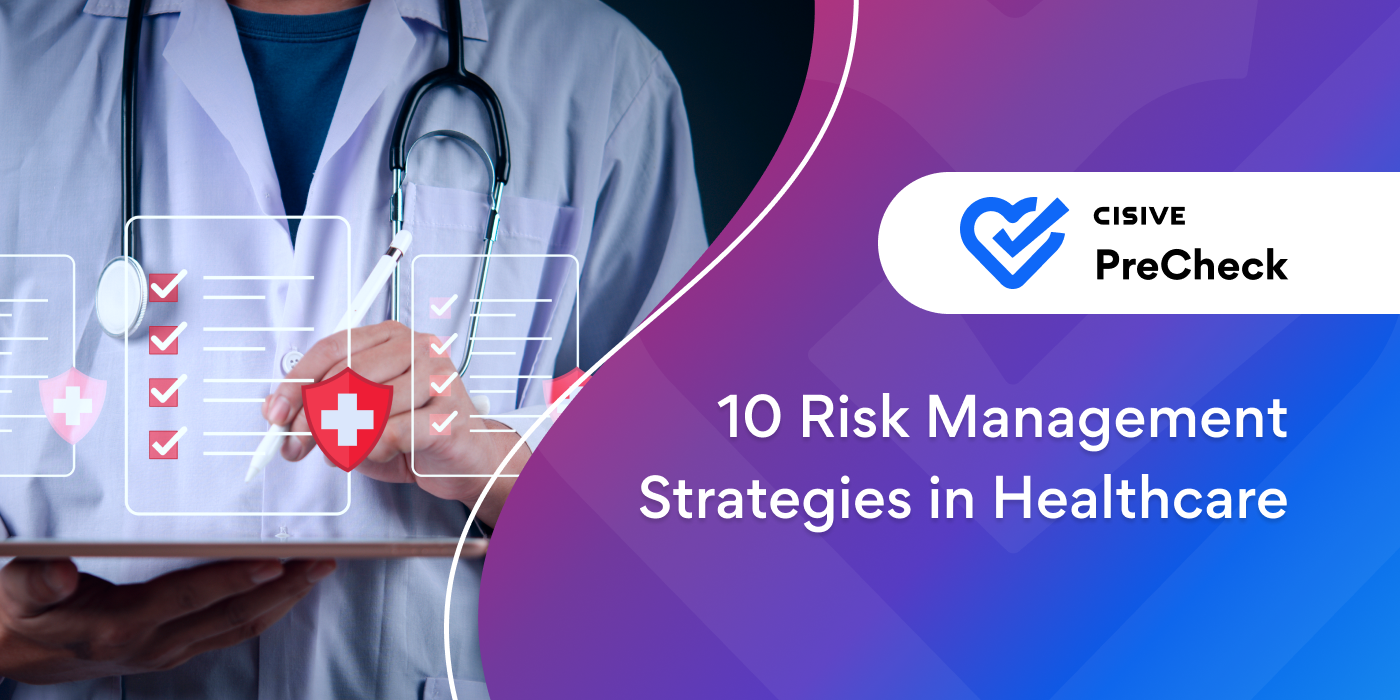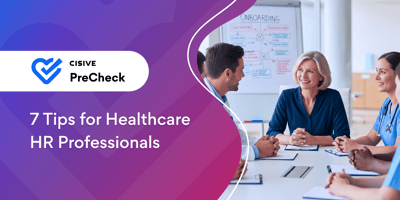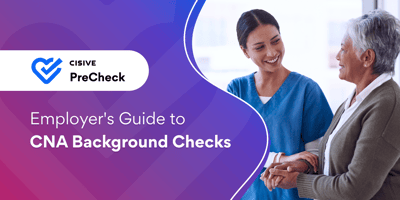

The healthcare industry is built on the physicians, nurses, clinicians, therapists, and support...

Every surgery, treatment, medication, and provider hiring decision has inherent risks, from financial and operational losses to life-or-death consequences. But these risks can be managed. Careful risk management requires anticipating these threats, addressing them before they escalate, and embedding prevention into every layer of operations.
This process is ongoing and requires a structured strategy. Otherwise, your organization could be exposed to real-life worst-case scenarios. Understand which risks are relevant to your organization, then build a structured action plan to identify, measure, and respond to each of them.
Key Takeaways
|
The healthcare industry is among the most tightly regulated and risk-sensitive sectors. Clinical errors are among the most visible and pressing concerns, but vulnerabilities such as compliance failures and weak internal processes are no less significant.
“First, do no harm” is core to any healthcare scenario, yet that risk remains. Studies have shown that medical or diagnostic errors are frighteningly common; some research suggests they are a leading cause of death.
Clinical and patient safety risks can include:
Misdiagnosis
Missed diagnosis
Medication errors
Surgical incidents
Falls and infections
Any instance of avoidable patient harm can also harm your organization’s reputation. The public expects procedures and treatments to be as safe as possible. Failure to deliver will harm this community trust. Choosing the best providers and carefully reviewing documents can help you avoid and manage risks.
Bringing in a provider without thoroughly vetting their proper licenses and certifications is extremely risky and even life-threatening to the patient population. A thorough hospital credentialing process checks documentation, education, identity, criminal history, sanctions and exclusions, disciplinary history, and much more.
When hospitals practice weak credentialing and fail to verify licenses, certifications, or disciplinary history, they risk having unqualified staff and bad actors treating patients. The consequences include medical malpractice lawsuits, regulatory fines, patient harm, and long-term damage to people’s trust in your organization.
Inadequate internal processes, like lax adherence to protocols or inconsistent documentation, can lead to operational risks. At the same time, leaning too heavily on one risk management process can make it hard to stay nimble.
If you’re not prepared for risk mitigation, disruptions like supply chain failures could put an immediate halt to patient care. A resilient organization can withstand these complexities while still supporting patient care.
Systems-level risks like improper data handling are especially important today. Quality electronic health records (EHRs) help protect data privacy, but when these tools are used incorrectly or experience outages, breaches or unauthorized data access can occur.
Even nonprofit organizations need to monitor financial flow carefully. Inadequate risk management strategies in healthcare can open the door to payer claims denials, billing fraud, or other losses.
Payers will refuse to compensate for providers who are not properly credentialed, for example. Denied claims mean lost revenue, delays, administrative burden, and increased patient responsibility.
The U.S. Department of Justice estimates that more than $100 billion is lost to fraud in healthcare every year, affecting both the cost and quality of healthcare today. Even if financial losses can’t be traced to fraud, inaccurate coding and billing practices can be a financial drain.
Noncompliance with federal, state, and local laws is very risky. Violations can lead to funding cuts or fines in the millions of dollars. Lawsuits, especially high-profile cases, will erode trust for patients, stakeholders, and future talent.
These regulations are in place to protect patient and provider safety. Unstructured healthcare risk management strategies can put all of this at risk.
There is a critical shortage of healthcare professionals across industries. There’s no single cause: Burnout, an aging population, insufficient training, reduced access to care, and fallout from the pandemic are all taking a toll. Staff experience safety risks, too, and violence in healthcare is a growing issue. A workplace that doesn’t actively improve recruiting, reduce turnover, and prevent burnout will feel the pressure.
Given these human capital risks, organizations can’t take shortcuts with credentialing and hiring. Carefully vetting new hires (including ongoing monitoring), providing quality training, and making a concerted effort to support the team can help mitigate these potential risks.

In healthcare, risk management is the structured process of identifying, analyzing, and mitigating risks to protect patients, staff, and organizational assets. It blends compliance, safety, and operational excellence.
An effective healthcare risk management plan includes:
Systematically tracking and analyzing incidents
Implementing credentialing and verification checks
Establishing policies and protocols that adapt to evolving regulations
Practicing continuous monitoring and staff training
Following thoughtful risk management strategies can transform an organization from reactive to proactive.
Risk will always exist, but healthcare organizations can take steps to reduce the likelihood of threats and the potential fallout.
A formal framework is the playbook for identifying, evaluating, prioritizing, monitoring, and responding to risks. It takes all of the relevant risks into account, then aligns departments to the same operational standards.
There are several ways to build this framework. Many healthcare organizations use a decision matrix risk assessment technique to identify potential risks and create responses. Although it’s impossible to predict every risk, using a thoughtful structure like this helps prevent guesswork and reactionary responses.
To err is human, but by systematically reviewing adverse events and near misses, hospitals can prevent repeat errors in patient safety.
Sentinel events, or a patient-safety event that results in death or serious harm, are especially important to track, as the Joint Commission and other accrediting bodies will review this information regularly. Poor sentinel event tracking will raise red flags about your organization.
A platform for incident reporting and documentation supports transparency and root cause analysis (RCA). For example, if a wrong-site surgical sentinel event occurs, you can use RCA to trace back to which procedures should have been followed. From there, you can adjust training and improve patient safety protocols.
Credentialing is your frontline defense against onboarding the wrong providers. Verifying provider qualifications, board certifications, and disciplinary history can reduce common risks like payer denials, regulatory penalties, liabilities, and patient harm.
The credentialing process can be lengthy, with more than a few forms, screening questions, and verifications to complete along the way. Using centralized document management and automation can speed up the process while keeping your organization compliant and audit-ready.
Before making an offer to a new provider, complete a thorough background check. Standard background checks will check identity, employment, education, and criminal history, but healthcare hiring requires even more review. Conduct drug testing, immunization tracking, license monitoring, and disciplinary history review to get the full picture.
Because healthcare professionals have access to sensitive patient data, careful pre-employment screening services ensure you hire only people you and your patients can trust.
Patients meet quite a few healthcare professionals along the way, and the handoff process can introduce opportunities for errors and miscommunications. For example, a nurse could forget to inform a physician that a patient’s blood pressure had changed during the night, or a receptionist could forget to tell the surgical team about a rescheduled patient. These omissions can throw off entire treatment plans.
Structured handoff tools like SBAR (situation, background, assessment, recommendation) reduce the likelihood of errors during shift changes. This playbook makes it much easier to communicate important information, even between teams. Continuity of care, where the same nurse cares for the same patient consistently, is also helpful for not missing anything.
Paper documentation and outdated technology leave gaps in tracking. Modern systems, specifically tailored to strategies for risk management in healthcare, help prevent noncompliance and incomplete processes.
Quality risk management technology keeps important information in a single secure location for easy access and monitoring. Continuous screening and automated compliance updates keep you in the game. If there are unusual billing patterns or changes to a provider’s credential status, for example, real-time tracking will send alerts.
Risk management is only as strong as the people executing it. Because regulations and medical advancements change all the time, fostering a culture of responsibility and ongoing learning can be extremely powerful.
Empower your workforce with educational resources for HR and compliance staff, continuing medical education (CME) for providers, and professional development for other employees.
As a risk-mitigation strategy, consider simulations and practice tools as part of ongoing training. Having the opportunity to practice communication and coordination in a controlled environment can build team confidence for when a real risk arises.
As much as we’d like to avoid them, critical events will happen. It could be a natural disaster, pandemic, cyberattack, a supply chain crisis, or something else.
Cybersecurity poses an especially significant threat in modern healthcare. Ransomware attacks, phishing attempts, and data breaches can compromise sensitive patient information and bring clinical operations to a standstill. A single EHR lockout can delay treatments and impact community trust. To keep your organization safe, create emergency preparedness plans that cover a range of scenarios.
Established methodologies, like the Strategic Toolkit for Assessing Risks (STAR), are supported by the World Health Organization as a way to respond to emergencies and hazards while mitigating risks. You can use established approaches or develop your own response plan that minimizes disruption and maintains continuity of care.
You must protect your human capital, especially during staffing shortages. Providing all employees with a safe and legally compliant working environment will support their needs and reduce exposure to lawsuits and penalties.
Stay current with important federal labor and employment regulations, including:
Americans with Disabilities Act (ADA)
Equal Employment Opportunity Commission (EEOC) and Title VII
Fair Labor Standards Act (FLSA)
Family and Medical Leave Act (FMLA)
National Labor Relations Act (NLRA)
Occupational Safety and Health Act (OSHA)
The Health Insurance Portability and Accountability Act (HIPAA) governs how organizations must protect patient information and prevent data breaches. The Health Information Technology for Economic and Clinical Health Act (HITECH), meanwhile, makes EHRs stronger and more useful. Healthcare compliance teams need to maintain data privacy and security safeguards, just as they would for physical safety.
There are many risk management strategies in healthcare, and beginning with a strong background check is one of the most controllable steps. Know which credentials your candidate does and doesn’t have, and make sure their background aligns with your needs.
Unlike basic background checks, Cisive PreCheck supports healthcare organizations with:
30+ years’ focused experience in healthcare
99.9994% background pull accuracy (highest in the industry)
31.8% time-to-fill reduction
Compliance with federal and state regulations
Highly responsive, always-on customer support
Risk management strategies in healthcare help proactive organizations make informed choices and be ready to react to a range of scenarios. By combining advanced technology with deep expertise in healthcare compliance, PreCheck helps organizations like yours protect patients, staff, and brand reputation.
Ready to tighten your compliance? Talk to a PreCheck pro who can show you how to mitigate risk.

The healthcare industry is built on the physicians, nurses, clinicians, therapists, and support...

Every hospital wants only qualified, verified providers delivering patient care, which makes the...

CNAs, or Certified Nursing Assistants, are the eyes, ears, and hands of patient care. Often an...